英语16种时态超经典整理
- 格式:docx
- 大小:462.37 KB
- 文档页数:9
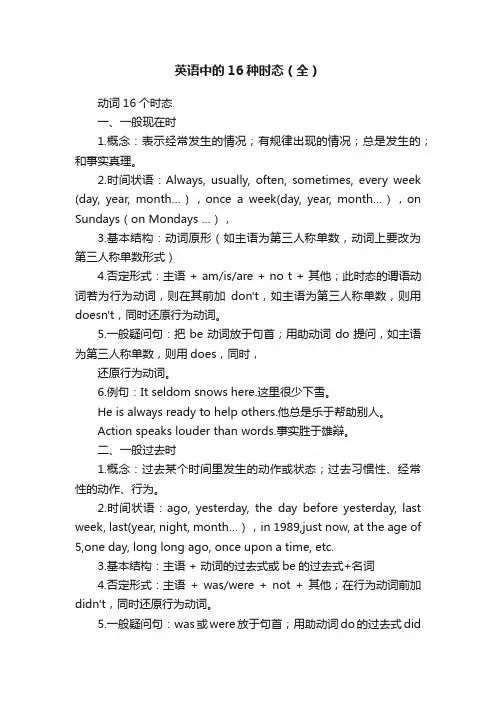
英语中的16种时态(全)动词16个时态一、一般现在时1.概念:表示经常发生的情况;有规律出现的情况;总是发生的;和事实真理。
2.时间状语:Always, usually, often, sometimes, every week (day, year, month…),once a week(day, year, month…),on Sundays(on Mondays …),3.基本结构:动词原形(如主语为第三人称单数,动词上要改为第三人称单数形式)4.否定形式:主语 + am/is/are + no t + 其他;此时态的谓语动词若为行为动词,则在其前加don't,如主语为第三人称单数,则用doesn't,同时还原行为动词。
5.一般疑问句:把be动词放于句首;用助动词do提问,如主语为第三人称单数,则用does,同时,还原行为动词。
6.例句:It seldom snows here.这里很少下雪。
He is always ready to help others.他总是乐于帮助别人。
Action speaks louder than words.事实胜于雄辩。
二、一般过去时1.概念:过去某个时间里发生的动作或状态;过去习惯性、经常性的动作、行为。
2.时间状语:ago, yesterday, the day before yesterday, last week, last(year, night, month…),in 1989,just now, at the age of 5,one day, long long ago, once upon a time, etc.3.基本结构:主语 + 动词的过去式或be的过去式+名词4.否定形式:主语 + was/were + not + 其他;在行为动词前加didn't,同时还原行为动词。
5.一般疑问句:was或were放于句首;用助动词do的过去式did提问,同时还原行为动词。

英语十六时态表格总结很全面英语中的时态是语法学习的重要部分,掌握好时态对于准确表达意思和理解英语语言至关重要。
下面为大家带来一份全面的英语十六时态表格总结。
|时态|构成|用法|例句||::|||||一般现在时|主语+动词原形(当主语为第三人称单数时,动词加 s 或 es)|表示经常发生的动作、习惯性的动作、客观事实、真理等|I go to school every day He likes playing football||一般过去时|主语+动词的过去式|表示过去发生的动作或存在的状态|I went to Beijing last year She was a teacher ten years ago||一般将来时|主语+ will/shall +动词原形主语+ be going to +动词原形|表示将来要发生的动作或存在的状态|I will visit my grandparents next week They are going to have a party tomorrow||过去将来时|主语+ would/should +动词原形主语+ was/were going to +动词原形|表示从过去某一时间来看将要发生的动作或存在的状态|He said he would come here the next day They thought they were going to have a meeting||现在进行时|主语+ am/is/are +现在分词|表示现在正在进行的动作|I am reading a book now They are playing basketball on the playground||过去进行时|主语+ was/were +现在分词|表示过去某个时刻正在进行的动作|I was watching TV at eight o'clock last night They were having a meeting when I came in||将来进行时|主语+ will/shall be +现在分词|表示将来某一时刻正在进行的动作|I will be sleeping at this time tomorrow They will be waiting for you at the airport||过去将来进行时|主语+ would/should be +现在分词|表示从过去某一时间来看将来某一时刻正在进行的动作|He said he would be working at this time the next day They thought they would be having a party at that time||现在完成时|主语+ have/has +过去分词|表示过去发生的动作对现在造成的影响或结果;过去发生的动作一直持续到现在|I have finished my homework He has lived here for ten years||过去完成时|主语+ had +过去分词|表示在过去某个时间之前已经完成的动作|I had learned 5000 words before I entered this school They had left before I arrived||将来完成时|主语+ will/shall have +过去分词|表示到将来某个时间为止已经完成的动作|I will have finished this work by the end of next month They will have been married for ten years by 2025||过去将来完成时|主语+ would/should have +过去分词|表示从过去某一时间来看,到将来某个时间为止已经完成的动作|He said he would have finished the work by the end of the next month They thought they would have been married for ten years by 2025||现在完成进行时|主语+ have/has been +现在分词|表示从过去某一时间开始一直持续到现在的动作,并且这个动作可能还会继续下去|I have been waiting for you for two hours They have been working on this project for a long time||过去完成进行时|主语+ had been +现在分词|表示过去某一时间之前一直在进行的动作|I had been studying English for five years before I went to college They had been waiting for the bus for half an hour when it finally came||将来完成进行时|主语+ will/shall have been +现在分词|表示到将来某个时间为止一直在进行的动作,并且这个动作可能还会继续下去|I will have been teaching for 30 years by the end of 2030、 They will have been building the bridge for two years by next month||过去将来完成进行时|主语+ would/should have been +现在分词|表示从过去某一时间来看,到将来某个时间为止一直在进行的动作,并且这个动作可能还会继续下去|He said he would have been waiting for me for two hours by the time I arrived They thought they would have been working on this project for a long time by the end of the year|为了更好地理解和掌握这些时态,我们可以通过大量的阅读、写作和口语练习来加深印象。
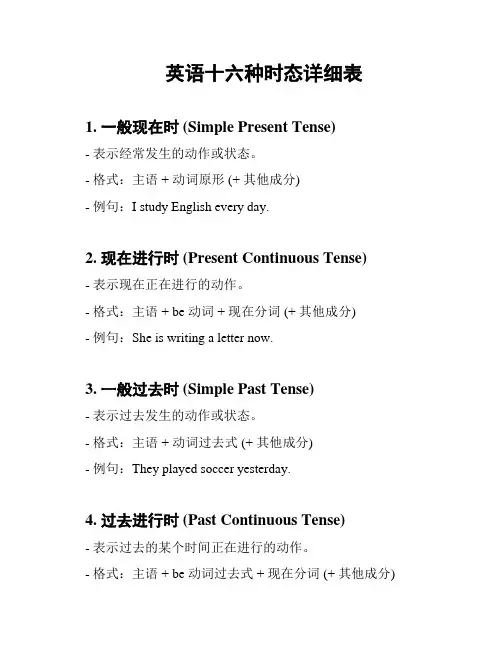
英语十六种时态详细表1. 一般现在时 (Simple Present Tense)- 表示经常发生的动作或状态。
- 格式:主语 + 动词原形 (+ 其他成分)- 例句:I study English every day.2. 现在进行时 (Present Continuous Tense)- 表示现在正在进行的动作。
- 格式:主语 + be 动词 + 现在分词 (+ 其他成分)- 例句:She is writing a letter now.3. 一般过去时 (Simple Past Tense)- 表示过去发生的动作或状态。
- 格式:主语 + 动词过去式 (+ 其他成分)- 例句:They played soccer yesterday.4. 过去进行时 (Past Continuous Tense)- 表示过去的某个时间正在进行的动作。
- 格式:主语 + be 动词过去式 + 现在分词 (+ 其他成分)- 例句:He was studying when I called him.5. 现在完成时 (Present Perfect Tense)- 表示过去发生的动作对现在产生的影响或仍然持续的动作。
- 格式:主语 + have/has + 过去分词 (+ 其他成分)- 例句:I have visited Paris.6. 过去完成时 (Past Perfect Tense)- 表示过去某个时间或动作之前发生的动作。
- 格式:主语 + had + 过去分词 (+ 其他成分)- 例句:She had already left when I arrived.7. 将来时 (Simple Future Tense)- 表示将来要发生的动作或状态。
- 格式:主语 + will/shall + 动词原形 (+ 其他成分)- 例句:We will visit our grandparents tomorrow.8. 现在完成进行时 (Present Perfect Continuous Tense)- 表示过去某个时间开始的动作一直持续到现在,并可能继续下去。
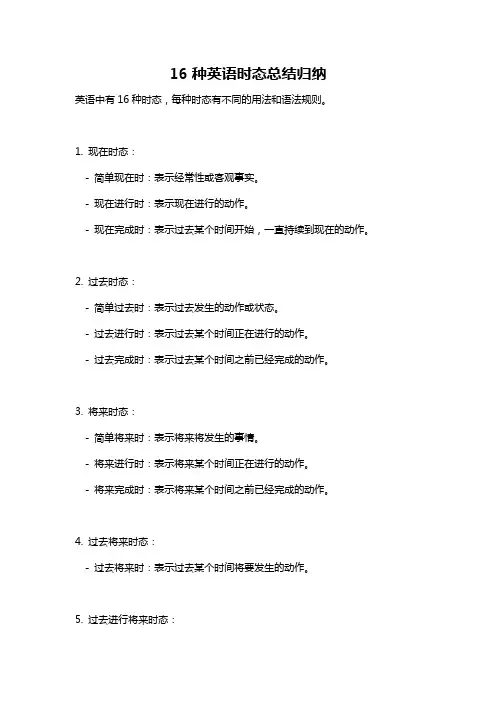
16种英语时态总结归纳英语中有16种时态,每种时态有不同的用法和语法规则。
1. 现在时态:- 简单现在时:表示经常性或客观事实。
- 现在进行时:表示现在进行的动作。
- 现在完成时:表示过去某个时间开始,一直持续到现在的动作。
2. 过去时态:- 简单过去时:表示过去发生的动作或状态。
- 过去进行时:表示过去某个时间正在进行的动作。
- 过去完成时:表示过去某个时间之前已经完成的动作。
3. 将来时态:- 简单将来时:表示将来将发生的事情。
- 将来进行时:表示将来某个时间正在进行的动作。
- 将来完成时:表示将来某个时间之前已经完成的动作。
4. 过去将来时态:- 过去将来时:表示过去某个时间将要发生的动作。
5. 过去进行将来时态:- 过去进行将来时:表示过去某个时间正在进行,将来会继续进行的动作或状态。
6. 过去完成将来时态:- 过去完成将来时:表示过去某个时间之前将会完成的动作。
7. 现在完成进行时:表示过去某个时间开始,一直持续到现在,并可能会继续进行的动作。
8. 现在完成完成时:表示过去某个时间开始,一直持续到现在,并已经完成的动作。
9. 过去完成进行时:表示过去某个时间之前已经开始,一直持续到过去某个时间的动作。
10. 现在完成将来时:表示将来某个时间之前已经开始,一直持续到现在,并将会继续进行的动作。
11. 过去完成将来进行时:表示过去某个时间将要发生的,将会持续到一个将来某个时间的动作。
12. 过去完成将来完成时:表示过去某个时间将会完成的动作。
13. 不定式:表示动作的目的、愿望、命令等。
14. 进行不定式:表示正在进行的不定式动作。
15. 完成不定式:表示已经完成的不定式动作。
16. 进行完成不定式:表示将来要完成的不定式动作。
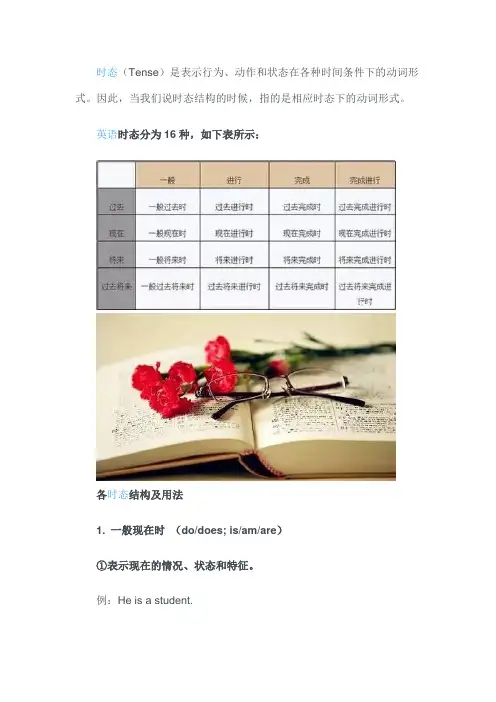
时态(Tense)是表示行为、动作和状态在各种时间条件下的动词形式。
因此,当我们说时态结构的时候,指的是相应时态下的动词形式。
英语时态分为16种,如下表所示:各时态结构及用法1. 一般现在时(do/does; is/am/are)①表示现在的情况、状态和特征。
例:He is a student.他是一个学生。
②表示经常性、习惯性动作。
例:He always helps others.他总是帮助别人。
③客观事实和普遍真理。
例:The earth moves the sun.地球绕着太阳转。
④表示一个按规定、计划或安排要发生的动作。
(常用于列车、客车、飞机或轮船时刻表)例:The next train leaves at 3 o'clock this afternoon.下一趟火车今天下午3点开车。
⑤主将从现:在时间、条件和让步状语从句中经常用一般现在表示将的来事情。
例:If it rains tomorrow, we will stay at home.如果明天下雨,我们会待在家里。
2. 现在进行时(am/is/are doing)①表示此时此刻正在发生的事情。
例:He is listning to the music now.他现在正在听音乐。
②表示目前一段时间内一直在做的事情,但不一定此时此刻正在做。
例:I am studying by using Qisu English APP this term.这个学期我一直在使用奇速英语APP学习。
③现在进行时可以表示将来的含义。
瞬时动词的进行一定表将来。
例:I am leaving.我要离开了。
持续动词的进行只有有将来的时间状语或有将来语境中才表将来。
例:I am travelling next month.下个月我要去旅行。
④现在进行时与频度副词连用,表示说话者或褒义或贬义的感情色彩。
例:He is always helping others.他总是帮助别人。
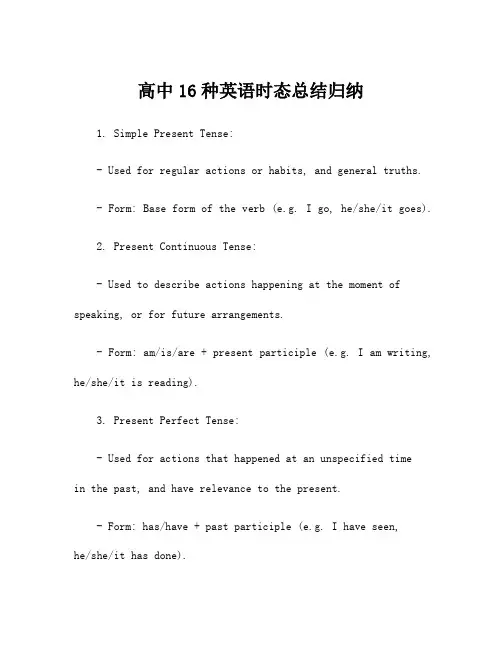
高中16种英语时态总结归纳1. Simple Present Tense:- Used for regular actions or habits, and general truths.- Form: Base form of the verb (e.g. I go, he/she/it goes).2. Present Continuous Tense:- Used to describe actions happening at the moment of speaking, or for future arrangements.- Form: am/is/are + present participle (e.g. I am writing, he/she/it is reading).3. Present Perfect Tense:- Used for actions that happened at an unspecified timein the past, and have relevance to the present.- Form: has/have + past participle (e.g. I have seen,he/she/it has done).4. Present Perfect Continuous Tense:- Used for actions that started in the past and continue into the present, and emphasize duration.- Form: has/have been + present participle (e.g. I have been waiting, he/she/it has been working).5. Simple Past Tense:- Used for actions that started and finished at aspecific time in the past.- Form: Past form of the verb (e.g. I went, he/she/it played).6. Past Continuous Tense:- Used to emphasize the duration of an action in the past, or for two actions happening simultaneously in the past.- Form: was/were + present participle (e.g. I was sleeping, he/she/it was writing).7. Past Perfect Tense:- Used to describe an action that happened before another action in the past.- Form: had + past participle (e.g. I had seen, he/she/it had finished).8. Past Perfect Continuous Tense:- Used to show the duration of an action that happened before another action in the past.- Form: had been + present participle (e.g. I had been waiting, he/she/it had been studying).9. Simple Future Tense:- Used to talk about actions that will happen in the future.- Form: will/shall + base form of the verb (e.g. I will go, he/she/it will eat).10. Future Continuous Tense:- Used to describe actions that will be ongoing at a specific time in the future.- Form: will/shall be + present participle (e.g. I will be waiting, he/she/it will be working).11. Future Perfect Tense:- Used for actions that will be completed before another action in the future.- Form: will have + past participle (e.g. I will have finished, he/she/it will have left).12. Future Perfect Continuous Tense:- Used to emphasize the duration of an action that will be completed before another action in the future.- Form: will have been + present participle (e.g. I will have been waiting, he/she/it will have been studying).13. Present Unreal Conditional:- Used to talk about hypothetical situations in the present or future, expressing results that are unlikely or impossible.- Form: if + simple past, would + base form (e.g. If I were rich, I would travel the world).14. Past Unreal Conditional:- Used to talk about hypothetical situations in the past, expressing results that didn't happen.- Form: if + past perfect, would have + past participle(e.g. If I had studied harder, I would have passed the test).15. Mixed Tenses:- Used to describe actions that happen at the same time but in the past and present or future.- Form: Mix of different tenses.16. Future Time Clauses:- Used to indicate two actions happening in the future, with the main clause in the future and the time clause in the present.- Form: Present tense in the time clause, will/shall or other future tense in main clause (e.g. When I am 25, I will have graduated).。
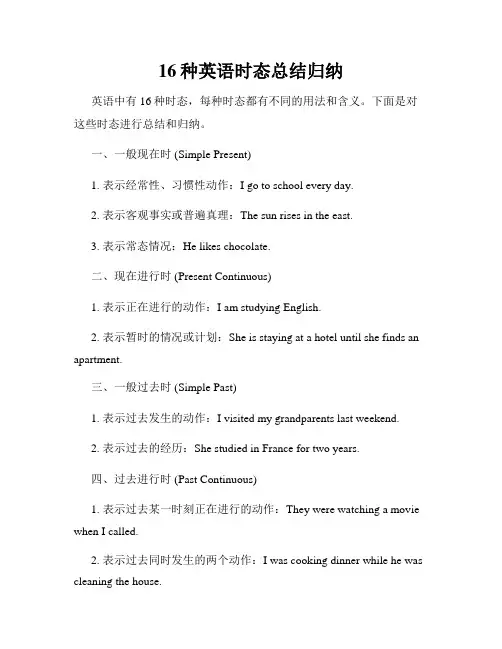
16种英语时态总结归纳英语中有16种时态,每种时态都有不同的用法和含义。
下面是对这些时态进行总结和归纳。
一、一般现在时 (Simple Present)1. 表示经常性、习惯性动作:I go to school every day.2. 表示客观事实或普遍真理:The sun rises in the east.3. 表示常态情况:He likes chocolate.二、现在进行时 (Present Continuous)1. 表示正在进行的动作:I am studying English.2. 表示暂时的情况或计划:She is staying at a hotel until she finds an apartment.三、一般过去时 (Simple Past)1. 表示过去发生的动作:I visited my grandparents last weekend.2. 表示过去的经历:She studied in France for two years.四、过去进行时 (Past Continuous)1. 表示过去某一时刻正在进行的动作:They were watching a movie when I called.2. 表示过去同时发生的两个动作:I was cooking dinner while he was cleaning the house.五、一般将来时 (Simple Future)1. 表示将要发生的动作:I will meet you at the park tomorrow.2. 表示决定或打算:We are going to have a party next weekend.六、将来进行时 (Future Continuous)1. 表示将来某一时刻正在进行的动作:They will be traveling to Europe this time next year.2. 表示持续性的动作:I will be working late tonight.七、现在完成时 (Present Perfect)1. 表示过去发生但与现在有关的动作:I have finished my homework.2. 表示经历或经验:He has traveled to many countries.八、过去完成时 (Past Perfect)1. 表示在过去某一时刻之前已经完成的动作:They had already left when I arrived.2. 表示顺序:She had read the book before watching the movie.九、将来完成时 (Future Perfect)1. 表示将来某一时刻之前完成的动作:I will have finished my project by tomorrow.2. 表示结果:They will have arrived by the time we get there.十、现在完成进行时 (Present Perfect Continuous)1. 表示从过去某一时刻开始一直持续到现在的动作:I have been studying for three hours.2. 表示强调动作的持续性:He has been working all day.十一、过去完成进行时 (Past Perfect Continuous)1. 表示过去某一时刻之前一直持续到过去的动作:She had been waiting for two hours when the bus finally arrived.2. 表示强调动作的持续性:They had been playing tennis all afternoon.十二、将来完成进行时 (Future Perfect Continuous)1. 表示将来某一时刻之前持续进行的动作:I will have been studying for five hours by the time the exam starts.2. 表示强调动作的持续性:They will have been working on the project for a month.十三、虚拟现在时 (Present Unreal)1. 表示与现在事实相反的假设:If I were rich, I would buy a mansion.2. 表示建议或要求:I suggest that he study more.十四、虚拟过去时 (Past Unreal)1. 表示与过去事实相反的假设:If I had studied harder, I would have passed the exam.2. 表示遗憾或后悔:I wish I had bought that dress.十五、虚拟将来时 (Future Unreal)1. 表示与将来事实相反的假设:If I won the lottery, I would travel the world.2. 表示不可能实现的愿望:I wish she would become a famous singer.十六、过去将来时 (Future in the Past)1. 表示过去某一时刻之后将要发生的动作:He said he would call me later.2. 表示过去的计划:I thought we were going to have dinner together.以上是对16种英语时态的总结归纳。
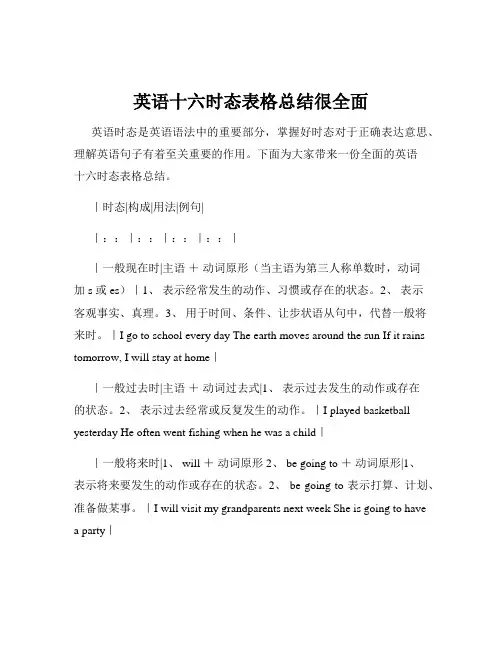
英语十六时态表格总结很全面英语时态是英语语法中的重要部分,掌握好时态对于正确表达意思、理解英语句子有着至关重要的作用。
下面为大家带来一份全面的英语十六时态表格总结。
|时态|构成|用法|例句||::|::|::|::||一般现在时|主语+动词原形(当主语为第三人称单数时,动词加 s 或 es)|1、表示经常发生的动作、习惯或存在的状态。
2、表示客观事实、真理。
3、用于时间、条件、让步状语从句中,代替一般将来时。
|I go to school every day The earth moves around the sun If it rains tomorrow, I will stay at home||一般过去时|主语+动词过去式|1、表示过去发生的动作或存在的状态。
2、表示过去经常或反复发生的动作。
|I played basketball yesterday He often went fishing when he was a child||一般将来时|1、 will +动词原形 2、 be going to +动词原形|1、表示将来要发生的动作或存在的状态。
2、 be going to 表示打算、计划、准备做某事。
|I will visit my grandparents next week She is going to have a party||过去将来时|1、 would +动词原形 2、 was/were going to +动词原形|表示从过去某一时间看将要发生的动作或存在的状态。
|He said he would come back the next day They were going to start at six o'clock||现在进行时|主语+ am/is/are +现在分词|1、表示现在正在进行的动作。
2、表示现阶段正在进行的动作,但说话时不一定正在进行。
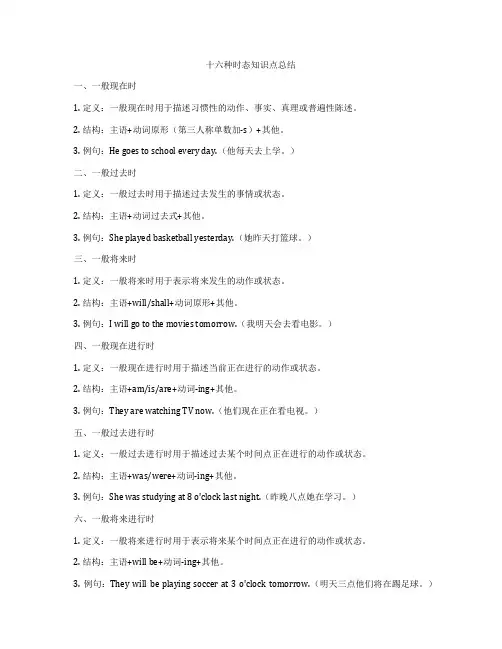
十六种时态知识点总结一、一般现在时1. 定义:一般现在时用于描述习惯性的动作、事实、真理或普遍性陈述。
2. 结构:主语+动词原形(第三人称单数加-s)+其他。
3. 例句:He goes to school every day.(他每天去上学。
)二、一般过去时1. 定义:一般过去时用于描述过去发生的事情或状态。
2. 结构:主语+动词过去式+其他。
3. 例句:She played basketball yesterday.(她昨天打篮球。
)三、一般将来时1. 定义:一般将来时用于表示将来发生的动作或状态。
2. 结构:主语+will/shall+动词原形+其他。
3. 例句:I will go to the movies tomorrow.(我明天会去看电影。
)四、一般现在进行时1. 定义:一般现在进行时用于描述当前正在进行的动作或状态。
2. 结构:主语+am/is/are+动词-ing+其他。
3. 例句:They are watching TV now.(他们现在正在看电视。
)五、一般过去进行时1. 定义:一般过去进行时用于描述过去某个时间点正在进行的动作或状态。
2. 结构:主语+was/were+动词-ing+其他。
3. 例句:She was studying at 8 o'clock last night.(昨晚八点她在学习。
)六、一般将来进行时1. 定义:一般将来进行时用于表示将来某个时间点正在进行的动作或状态。
2. 结构:主语+will be+动词-ing+其他。
3. 例句:They will be playing soccer at 3 o'clock tomorrow.(明天三点他们将在踢足球。
)七、一般现在完成时1. 定义:一般现在完成时用于描述过去发生的动作对当前的影响或结果。
2. 结构:主语+have/has+动词过去分词+其他。
3. 例句:She has finished her homework.(她已经完成了她的作业。
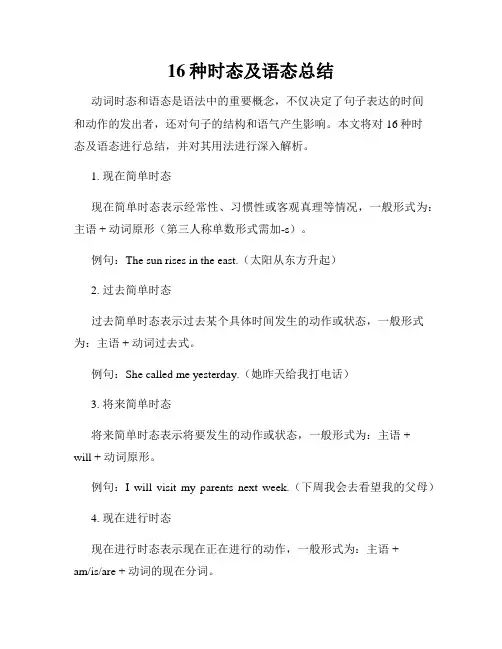
16种时态及语态总结动词时态和语态是语法中的重要概念,不仅决定了句子表达的时间和动作的发出者,还对句子的结构和语气产生影响。
本文将对16种时态及语态进行总结,并对其用法进行深入解析。
1. 现在简单时态现在简单时态表示经常性、习惯性或客观真理等情况,一般形式为:主语 + 动词原形(第三人称单数形式需加-s)。
例句:The sun rises in the east.(太阳从东方升起)2. 过去简单时态过去简单时态表示过去某个具体时间发生的动作或状态,一般形式为:主语 + 动词过去式。
例句:She called me yesterday.(她昨天给我打电话)3. 将来简单时态将来简单时态表示将要发生的动作或状态,一般形式为:主语 +will + 动词原形。
例句:I will visit my parents next week.(下周我会去看望我的父母)4. 现在进行时态现在进行时态表示现在正在进行的动作,一般形式为:主语 +am/is/are + 动词的现在分词。
例句:They are studying in the library now.(他们现在正在图书馆学习)5. 过去进行时态过去进行时态表示过去某一时刻正在进行的动作,一般形式为:主语 + was/were + 动词的现在分词。
例句:I was watching TV when he called me.(他给我打电话的时候,我正在看电视)6. 将来进行时态将来进行时态表示将来某一时刻正在进行的动作,一般形式为:主语 + will be + 动词的现在分词。
例句:She will be studying abroad this time next year.(明年这个时候她将在国外留学)7. 现在完成时态现在完成时态表示过去发生的动作对现在造成的影响或状态,一般形式为:主语 + have/has + 动词的过去分词。
例句:He has already finished his homework.(他已经完成了作业)8. 过去完成时态过去完成时态表示过去某个时间或动作发生之前已经完成的动作,一般形式为:主语 + had + 动词的过去分词。
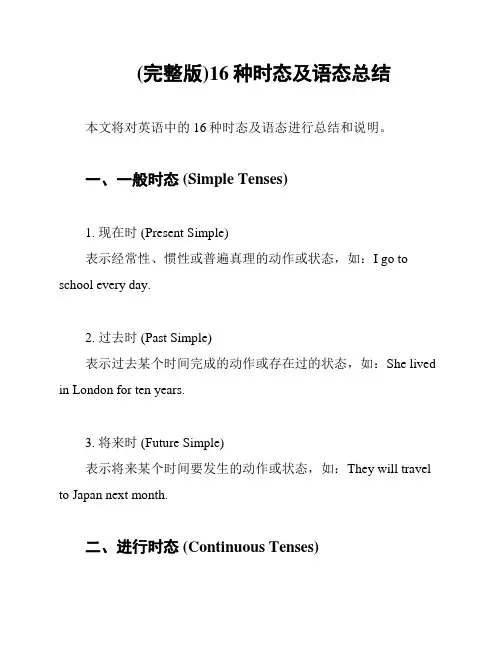
(完整版)16种时态及语态总结本文将对英语中的16种时态及语态进行总结和说明。
一、一般时态 (Simple Tenses)1. 现在时 (Present Simple)表示经常性、惯性或普遍真理的动作或状态,如:I go to school every day.2. 过去时 (Past Simple)表示过去某个时间完成的动作或存在过的状态,如:She lived in London for ten years.3. 将来时 (Future Simple)表示将来某个时间要发生的动作或状态,如:They will travel to Japan next month.二、进行时态 (Continuous Tenses)4. 现在进行时 (Present Continuous)表示现在正在进行的动作,如:He is studying for the exam.5. 过去进行时 (Past Continuous)表示过去某个时间正在进行的动作,如:We were playing soccer at that time.6. 将来进行时 (Future Continuous)表示将来某个时间将正在进行的动作,如:They will be working on a project at that time.三、完成时态 (Perfect Tenses)7. 现在完成时 (Present Perfect)表示过去某时开始的动作一直延续到现在,或对现在造成影响的过去动作,如:I have seen that movie before.8. 过去完成时 (Past Perfect)表示过去某个时间或动作之前已经发生的动作,如:She had already finished her homework when I arrived.9. 将来完成时 (Future Perfect)表示将来某个时间之前已经完成的动作,如:By the time he arrives, I will have finished cooking.四、完成进行时态 (Perfect Continuous Tenses)10. 现在完成进行时 (Present Perfect Continuous)表示从过去某个时刻开始一直延续到现在,且可能还会继续下去的动作,如:They have been waiting for the bus for an hour.11. 过去完成进行时 (Past Perfect Continuous)表示过去某个时间之前一直进行的动作,如:She had been studying English for two hours before she went to bed.12. 将来完成进行时 (Future Perfect Continuous)表示将来某个时间之前一直进行的动作,如:By the time he arrives, I will have been working for 8 hours.五、被动语态 (Passive Voice)13. 现在被动语态 (Present Passive)表示主语是动作的接受者,如:The book is written by the author.14. 过去被动语态 (Past Passive)表示过去发生的动作的接受者,如:The letter was sent by mail.15. 将来被动语态 (Future Passive)表示将来动作的接受者,如:The package will be delivered by courier.16. 现在完成被动语态 (Present Perfect Passive)表示过去某个时间开始的动作一直延续到现在,且主语是动作的接受者,如:The car has been repaired by a mechanic.以上是英语中的16种时态及语态的总结,希望对你的研究有所帮助。
16种英语时态总结归纳第1篇1.概念:在将来某一时刻之前开始的动作或状态2.时间状语:by the time of; by the end of + 时间短语(将来);by the time +从句(将来)3.基本结构:主语 + be going to/will/shall + have + (过去分词) + 其它4例句:By the time you get back, great changes will have taken place in thisarea.到你回来的时候,就将发生巨大的变化。
16种英语时态总结归纳第2篇概念:经常、反复发生的动作或行为及现在的某种状况。
时间状语: always, usually, often, sometimes, every week (day, year, month…), once a week, on Sundays基本结构:① be 动词;xxx动词否定形式:① am/is/are+not;②谓语动词若为实义动词,A.主语不是三单式,则don't+动词原形B.主语为三单式,则 doesn't+动词原形。
一般疑问句:①把 be动词放于句首;②谓语动词若为实义动词,A.主语不是三单式,用助动词Do+主语+动词原形B.主语为三单式,则Does+主语+动词原形Helen ________ a good student.(be)Helen ________ fishing very much.(like)Helen’s friends usually ________ to school by bike.(go)16种英语时态总结归纳第3篇1.概念:表示现阶段或说话时正在进行的动作及行为。
2.时间状语:Now, at this time, days, etc. look, listen3.基本结构:主语 + be + doing + 其它4.否定形式:主语 + be + not +doing + 其它5.一般疑问句:把be动词放于句首。
中考英语中的16种时态整理附例句英语中的16种时态(时态整理附例句),你会熟练地运用吗?1. 一般现在时(do/does; is/am/are)①现在的动作、情况、状态和特征。
例:She is a teacher.她是一位老师②经常性、习惯性动作。
例:He always helps others.他总是帮助别人。
③客观事实和普遍真理。
如果前后文不是一般现在时,则无法保持主句、从句时态一致。
例:The earth moves round the sun.地球绕着太阳转。
④表示一个按规定、计划或安排要发生的动作。
例:The next train leaves at 3 o'clock this afternoon.下一趟火车/EIYQsbs 。
⑤在时间和条件状语从句里经常用一般现在(有时也用现在完成时)表示将来事情。
例:When you have finished the report, I will have waited for about 3 hours.等你完成这份报告的时候,我就已经等了将近3个小时了。
2. 现在进行时(am/is/are doing)①表示此时此刻正在发生的事情。
例:He is listning to the music now.他现在正在听音乐。
②表示目前一段时间内一直在做的事情,但不一定此时此刻正在做。
例:I am studying computer this term.这个学期我一直在学习计算机。
③现在进行时可以表示将来的含义。
瞬时动词的进行一定表将来。
例:I am leaving.我要离开了。
持续动词的进行只有有将来的时间状语或有将来语境中才表将来。
例:I am travelling next month.下个月我要去旅行。
④现在进行时与频度副词连用,表示说话者或褒义或贬义的感情色彩。
例:He is always helping others.他总是帮助别人。
【整理】英语16种时态表一、一般现在时一般现在时表示经常发生或习惯性的动作、状态或真理。
其结构为:主语 + 动词原形(第三人称单数加s/es)。
例句:He goes to school bike every day.(他每天骑自行车上学。
)二、一般过去时一般过去时表示过去某个时间发生的动作或存在的状态。
其结构为:主语 + 动词过去式。
例句:I visited the Great Wall last year.(去年我参观了长城。
)三、一般将来时一般将来时表示将来某个时间会发生的动作或存在的状态。
其结构为:will + 动词原形。
例句:She will graduate from college next year.(她明年将大学毕业。
)四、现在进行时现在进行时表示正在进行的动作或状态。
其结构为:主语 + be动词(am/is/are) + 现在分词。
例句:They are watching a movie in the cinema.(他们正在电影院看电影。
)五、过去进行时过去进行时表示在过去某个时间正在进行的动作或状态。
其结构为:主语 + was/were + 现在分词。
例句:She was reading a book when I called her.(我给她打电话时,她正在看书。
)六、将来进行时将来进行时表示将来某个时间正在进行的动作或状态。
其结构为:will be + 现在分词。
例句:In two hours, we will be sitting in the classroom.(两小时后,我们将坐在教室里。
)七、现在完成时现在完成时表示过去发生的动作对现在造成的影响或结果,常与时间状语since, for, already, yet等连用。
其结构为:主语 +have/has + 过去分词。
例句:She has already finished her homework.(她已经完成了她的家庭作业。
动词16个时态一、一般现在时1.概念:表示经常发生的情况;有规律出现的情况;总是发生的;和事实真理。
2.时间状语:Always, usually, often, sometimes, every week (day, year, month…),once a week(day, year, month…),on Sundays(on Mondays …),3.基本结构:动词原形(如主语为第三人称单数,动词上要改为第三人称单数形式)4.否定形式:主语 + am/is/are + no t + 其他;此时态的谓语动词若为行为动词,则在其前加don't,如主语为第三人称单数,则用doesn't,同时还原行为动词。
5.一般疑问句:把be动词放于句首;用助动词do提问,如主语为第三人称单数,则用does,同时,还原行为动词。
6.例句:It seldom snows here.这里很少下雪。
He is always ready to help others.他总是乐于帮助别人。
Action speaks louder than words.事实胜于雄辩。
二、一般过去时1.概念:过去某个时间里发生的动作或状态;过去习惯性、经常性的动作、行为。
2.时间状语:ago, yesterday, the day before yesterday, last week, last(year, night, month…),in 1989,just now, at the age of 5,one day, long long ago, once upon a time, etc.3.基本结构:主语 + 动词的过去式或be的过去式+名词4.否定形式:主语 + was/were + not + 其他;在行为动词前加didn't,同时还原行为动词。
5.一般疑问句:was或were放于句首;用助动词do的过去式did 提问,同时还原行为动词。
英语的16种时态之袁州冬雪创作1.一般现在时the present tense2.一般过去时the past tense3.一般将来时the future tense4.一般过去将来时the past future tense5.现在停止时the present continuous tense6.过去停止时the past Continuous Tense7.将来停止时the future continuous tense8.过去将来停止时the past future continuous tense9.现在完成时the Present Perfect Tense10.过去完成时the Past Perfect Tense11.将来完成时the future perfect tense12.过去将来完成时the past future perfect tense13.现在完成停止时the present perfect continuous tense14.过去完成停止时the past perfect continuous tense15.将来完成停止时the future perfect continuous tense16.过去将来完成停止时the past future perfect continuous tense一、一般时态1、一般现在时(1)一般现在时暗示没有时限的持久存在的动作或状态或现阶段反复发生的动作或状态,常和副词usually,often,always sometimes,regularly,near,occasionally,every year, every week 等连用.例如:1)The moon moves round the earth..2)Mr. Smith travels to work by bus every day.(2)在由after,until,before,once,when,even if,in case,as long as,as soon as,the moment 以及if,unless 等引导的时间状语从句或条件状语从句中,通常常使用一般现在时代替将来时.例如:1)I will tell him the news as soon as I see him.2)I will not go to countryside if it rains tomorrow.(3)某些暗示起始的动词,可用一般现在时暗示按规定、计划或安插要发生的动作,这类动词有:be,go,come,start,depart,arrive,begin,leave 等.例如:1)The plane leaves at three sharp.2)The new teachers arrive tomorrow.(4)在由why,what,where,whoever,who,that,as 等引导的从句中,也常常使用一般现在时代替将来时.例如:1)Free tickets will be given to whoever comes first.2)You’ll probably be in the same train as I am tomorrow.2.一般过去时(1)暗示过去某一特定时间所发生的、可完成的动作或状态,常与暗示确切过去时间的词、短语或从句连用.例如:We went to the pictures last night and saw a very interesting film.(2)暗示过去习惯性动作.例如:1)He always went to class last.2)I used to do my homework in the library.(注意与be used to doing短语的区别)3.一般将来时1)暗示将来打算停止或期待发生的动作或状态.例如:I shall graduate next year.2)几种替代形式:1)be going to +v在白话中广泛使用,暗示准备做或将发生的事情.例如:I’m going to buy a house when we’ve saved enough money.2)be to +v暗示计划安插要做的事,具有“需要”的强制性意义.例如:I am to play tennis this afternoon.3)be about to +v暗示即将发生的事情.例如:He was about to start.4)be due to +v暗示预先确定了的事,必定发生的事.例如:The train is due to depart in ten minutes.5)be on the point/verge of +v –ing强调即将发生的某种事态.例如:The baby was on the point of crying when her mother finally came home.二、停止时态1.现在停止时(1)暗示现在正在停止的动作,常与now,right now,at the mother,for the time being,for the present等连用.例如:Don’t d isturb her. She is reading a newspaper now.(2)暗示现阶段常常发生的动作,常与always,continually,forever,constantly等连用.例如:My father is forever criticizing me.(3)暗示根据计划或安插在最近要停止的事情.具有这种语法功能的动词仅限于过渡性动词.即暗示从一个状态或位置转移到另外一个状态或位置上去的动词.常常使用的有:go,come,leave,start,arrive,return 等.例如:They are leaving for Hong Kong next month.(4)有些动词不克不及用停止时,这是一类暗示“感觉,感情,存在,从属”等的动词.如:see,hear,smell,taste,feel,notice,look,appear,(暗示感觉的词);hate,love,fear,like,want,wish,prefer,refuse,forgive(暗示感情的动词);be,exist,remain,stay,obtain(暗示存在状态的动词);have,possess,own,contain,belong,consist of,form(暗示占有与从属的动词);understand,know,believe,think,doubt,forget,remember(暗示思考懂得的动词).但是如果它们词义改变,便也可用停止时态.例如:1)Tom looks pale. What’s wrong with him?(look 在此为接洽动词,意为“显得,看上去”)2)Tom is looking for his books.(look 在此为实义动词,意为“寻找”)2.过去停止时过去停止时暗示一个过去的动作发生时或发生后,另外一个过去的动作正在停止,或暗示过去反复的习惯,常与always,continually,constantly等动词连用.例如:1)We were discussing the matter when the headmaster entered.2)Whenever I visited him, he was always writing at the desk.3.将来停止时将来停止时主要暗示将来某一时刻正在停止的动作,或暗示要在将来某一时刻开端,并继续下去的动作.常常使用来暗示礼貌的询问、请求等.例如:1)This time next day they will be sitting in the cinema.2)What will you be doing at six tomorrow evening?4.完成停止时(现在、过去、将来)完成停止时是(现在、过去、将来)完成时的强调形式,将放在完成时态部分讲述.三、完成时态完成时态通常暗示已完成或从事的动作.它可分为:1.现在完成时(1)现在完成时用来暗示对今朝状况仍有影响的,刚刚完成的动作(常与yet,already,just连用),或者过去某一时刻发生的,持续到现在的情况(常与for,since连用).例如:1)I have just finished my homework.2)Mary has been ill for three days.(2)常与现在完成时连用的时间状语有:since, for, during, over等引导出的短语;副词already, yet, just, ever, now, before, often, lately, recently等;状语词组this week (morning, month, year), so far, up to now, many times, up to the present等.例如:1)I haven’t been there for five years.2)So far, she hasn’t enjoyed the summer vacation.3)There have been a lot of changes since 1978.(3)完成时态可用在下列布局中:This (That, It) is (was) the first (second…) time +定语从句;This (That, It) is (was) the only (last) + n +定语从句;This (That, It) is (was) +形容词最高级+ n +定语从句.如果主句的谓语动词是一般现在时,从句的谓语动词通常常使用现在完成时;如果主句谓语动词是一般过去时,从句谓语动词通常常使用过去完成时.例如:(1)This is one of the rarest questions that have ever been raised at such a meeting.(2)There was a knock at the door. It was the second time someone had interrupted me that evening.2.过去完成时(1)暗示过去某时间前已经发生的动作或情况,这个过去的时间可以用by,before等介词短语或一个时间状语从句来暗示;或者暗示一个动作在另外一个过去动作之前已经完成.例如:1)We had just had our breakfast when Tom came in.2)By the end of last year they had turned out 5, 000 bicycles.(2)动词expect, hope, mean, intend, plan, suppose, wish, want, desire等用过去完成时,暗示过去的希望、预期、意图或愿望等没有实现.例如:I had meant to take a good holiday this ye ar, but I wasn’t able to get away.别的两种暗示“过去想做而未做的事”的表达方式是:1)was / were + to have done sth, 例如:We were to have come yesterday, but we couldn’t.2)intended (expected, hope, meant, planned, supposed, wished, wanted, desired) + to have done sth, 例如:I meant to have told you about it, but I forgot to do so.(3)过去完成时常常使用于以下固定句型:1)hardly, scarcely, barely + 过去完成时+ when + 过去时.例如:Hardly had I got on the bus when it started to move.2)no sooner +过去完成时+ than +过去时.例如:No sooner had I gone out than he came to see me.3)by (the end of ) +过去时间,主句中谓语动词用过去完成时.例如:The experiment had been finished by 4 o’clock yesterday afternoon.3.将来完成时将来完成时暗示在将来某一时刻将完成或在另外一个未来的动作发生之前已经完成的动作;也可以用来暗示一种猜测.常与将来完成时连用的时间状语有:by (the time / the end of ) + 暗示将来时间的短语和句子;before (the end of ) + 暗示将来时间的词语或句子;when, after等加上暗示将来动作的句子等.例如:1)By this time tomorrow you will have arrived in Shanghai.2)I shall have finished this composition before 9 o’clock.3)When we get on the railway station, the train will probably have left.4.完成停止时完成停止时是完成时的强调形式,有现在完成停止时,过去完成停止时,将来完成停止时.(1)现在完成停止时暗示过去某一时刻之前开端的动作或状态一直延续到过去某一时刻.例如:I have been looking for my lost book for three days, but I still haven’t found it.(2)过去完成停止时暗示过去某一时刻之前开端的动作或状态一直延续到过去某一时刻.例如:It had been raining cats and dogs for over a week and the downpour had caused landslides in many places.(3)将来完成停止时暗示在将来某一时刻之前开端的一个动作或状态一直延续到将来某一时刻.例如:By the time you arrive tonight, she will have been typing for hours.四:时态一致时态一致是英语四、六级测验的一个重要内容.通常应由主句谓语的时态决议从句的谓语时态.一般原则是:1、当主句谓语使用现在时或将来时,从句的谓语根据详细情况使用任何时态He says that he lives in Wuhan.We hope that there will be many people at your party today.“Did you hear that Bill finally sold the house?” “Yes, but I don’t know who bought it.”“There’s a lot of excitement on the street.”“There certainly is. Do you suppose the astronauts have returned?”2、当主句谓语使用过去时的时候,从句的谓语必须使用过去范围的时态He said he was writing a novel.The teacher wanted to know when we would finish the experiment.He said his father had been an engineer.3、当从句是暗示没有时间概念的真理时,从句的谓语应使用一般现在时.例如:The teacher told them since light travels faster than sound, lightning appears to go before thunder.注:在此种情况下,即使主句谓语用了过去式的各种时态,从句谓语也应用一般现在时.4、从句谓语只能用虚拟语气的情况操纵时态一致原则确定从句动词时态时,还应注意,若主语动词是暗示饬令、请求、要求、建议、劝告等的动词,从句谓语只能用虚拟语气,不克不及遵循时态一致原则.例如:We insisted that we do it ourselves.动词的语态语态也是动词的一种形式,英语有两种语态:主动语态和主动语态.主动语态暗示主语是动作的执行者,而主动语态暗示主语是动作的承受者.1)We use electricity to run machines.(主动语态)2)Electricity is used to run machines.(主动语态)1.不克不及用于主动语态的动词和短语(1)在英语中,不及物动词不克不及用于主动语态,但有些不及物动词(包含短语)容易引起误用.如:appear, belong, belong, die, escape, fall, happen, last, remain, succeed, occur, come true, take place, consist of.(2)某些暗示状态或特征的及物动词,如:become, contain, cost, fit, have, resemble, suit也没有主动语态.2.主动语态的时态形式常常使用的主动语态有表1 所列的几种时态形式.表1时间一般时停止时完成时现在am askedam being askedis askedis being askedare asked are being asked过去was be askedwas being askedwere be asked were being asked将来shall be asked shall have been askedwill be askedwill have been asked过去should be asked should have been asked将来would be asked would have been asked3.短语动词的主动语态短语动词转换为主动语态时,通常被看做是一个动词,后面的介词或副词不克不及拆开或省略.例如:1)So far no correct conclusion has arrived at.2)All the rubbish should be got rid of.4.“get + -ed分词”的主动语态“get + -ed分词”布局强调动作的成果,而非动作自己,常常使用来暗示突发性的,出乎意料的偶尔事件.例如:The boy got hurt on his way home from work.别的,“get + -ed分词”还可用于谈论为自己做的事,是主动的行为而不是主动的行为.例如:get dressed(穿衣服)get divorced(离婚)get engaged(订婚)get confused(困惑不解)get lost(迷路)get washed(洗脸)get married(成婚)5.能带两个宾语和复合宾语的动词改为主动语态(1)能带两个宾语的动词改为主动语态时,一次只能由一个宾语作主语,另外一个宾语被保存下来.例如:1)We showed the visitors our new products.(主动语态)2)The visitors were shown our new products.(主动语态)3)Our new products were shown to the visitors.(主动语态)(2)能带复合宾语的动词改为主动语态时,原来的宾语补足语变成主语补足语.例如:1)The teacher appointed him League secretary.(主动语态)2)He was appointed League secretary.(主动语态)6.主动语态与系表布局的区别(1)The novel was well written.(系表布局)(2)The novel was written by Diskens.(主动语态)7.少数动词的主动语态有时有主动的意思例1:The book is selling remarkably well.例2:The song sounds very beautiful.能这样用的动词还有read(读起来),clean(擦起来),wash(洗起来),write(写起来).例3:My watch needs cleaning. (= My watch needs to be cleaned).能像need这样用的动词还有:want, require, deserve, do, owe, bind等.例4:The meat is cooking.例5:The book written by the professor is printing.。
英语的16种时态1.一般现在时the present tense2.一般过去时the past tense3.一般将来时the future tense4.一般过去将来时the past future tense5.现在进行时the present continuous tense6.过去进行时the past Continuous Tense7.将来进行时the future continuous tense8.过去将来进行时the past future continuous tense9.现在完成时the Present Perfect Tense10.过去完成时the Past Perfect Tense11.将来完成时the future perfect tense12.过去将来完成时the past future perfect tense13.现在完成进行时the present perfect continuous tense14.过去完成进行时the past perfect continuous tense15.将来完成进行时the future perfect continuous tense16.过去将来完成进行时the past future perfect continuous tense1、一般现在时(1)一般现在时表示没有时限的持久存在的动作或状态或现阶段反复发生的动作或状态,常和副词usually,often,always sometimes,regularly,near,occasionally,every year, every week 等连用。
例如:1)The moon moves round the earth..2)Mr. Smith travels to work by bus every day.(2)在由after,until,before,once,when,even if,in case,as long as,as soon as,the moment 以及if,unless 等引导的时间状语从句或条件状语从句中,通常用一般现在时代替将来时。
例如:1)I will tell him the news as soon as I see him.2)I will not go to countryside if it rains tomorrow.(3)某些表示起始的动词,可用一般现在时表示按规定、计划或安排要发生的动作,这类动词有:be,go,come,start,depart,arrive,begin,leave 等。
例如:1)The plane leaves at three sharp.2)The new teachers arrive tomorrow.(4)在由why,what,where,whoever,who,that,as 等引导的从句中,也常用一般现在时代替将来时。
例如:1)Free tickets will be given to whoever comes first.2)You’ll probably be in the same train as I am tomorrow.2.一般过去时(1)表示过去某一特定时间所发生的、可完成的动作或状态,常与表示确切过去时间的词、短语或从句连用。
例如:We went to the pictures last night and saw a very interesting film.(2)表示过去习惯性动作。
例如:1)He always went to class last.2)I used to do my homework in the library.(注意与be used to doing短语的区别)3.一般将来时1)表示将来打算进行或期待发生的动作或状态。
例如:I shall graduate next year.2)几种替代形式:1)be going to +v在口语中广泛使用,表示准备做或将发生的事情。
例如:I’m going to buy a house when we’ve saved enough money.2)be to +v表示计划安排要做的事,具有“必要”的强制性意义。
例如:I am to play tennis this afternoon.3)be about to +v表示即将发生的事情。
例如:He was about to start.4)be due to +v表示预先确定了的事,必定发生的事。
例如:The train is due to depart in ten minutes.5)be on the point/verge of +v –ing 强调即将发生的某种事态。
例如:The baby was on the point of crying when her mother finally came home.1.现在进行时(1)表示现在正在进行的动作,常与now,right now,at the mother,for the time being,for the present等连用。
例如:Don’t disturb her. She is reading a newspaper now.(2)表示现阶段经常发生的动作,常与always,continually,forever,constantly等连用。
例如:My father is forever criticizing me.(3)表示根据计划或安排在最近要进行的事情。
具有这种语法功能的动词仅限于过渡性动词。
即表示从一个状态或位置转移到另一个状态或位置上去的动词。
常用的有:go,come,leave,start,arrive,return等。
例如:They are leaving for Hong Kong next month.(4)有些动词不能用进行时,这是一类表示“感觉,感情,存在,从属”等的动词。
如:see,hear,smell,taste,feel,notice,look,appear,(表示感觉的词);hate,love,fear,like,want,wish,prefer,refuse,forgive(表示感情的动词);be,exist,remain,stay,obtain(表示存在状态的动词);have,possess,own,contain,belong,consist of,form(表示占有与从属的动词);understand,know,believe,think,doubt,forget,remember(表示思考理解的动词)。
但是如果它们词义改变,便也可用进行时态。
例如:1)Tom looks pale. What’s wrong with him?(look 在此为联系动词,意为“显得,看上去”)2)Tom is looking for his books.(look 在此为实义动词,意为“寻找”)2.过去进行时过去进行时表示一个过去的动作发生时或发生后,另一个过去的动作正在进行,或表示过去反复的习惯,常与always,continually,constantly等动词连用。
例如:1)We were discussing the matter when the headmaster entered.2)Whenever I visited him, he was always writing at the desk.3.将来进行时将来进行时主要表示将来某一时刻正在进行的动作,或表示要在将来某一时刻开始,并继续下去的动作。
常用来表示礼貌的询问、请求等。
例如:1)This time next day they will be sitting in the cinema.2)What will you be doing at six tomorrow evening?4.完成进行时(现在、过去、将来)完成进行时是(现在、过去、将来)完成时的强调形式,将放在完成时态部分讲述。
完成时态通常表示已完成或从事的动作。
它可分为:1.现在完成时(1)现在完成时用来表示对目前状况仍有影响的,刚刚完成的动作(常与yet,already,just连用),或者过去某一时刻发生的,持续到现在的情况(常与for,since连用)。
例如:1)I have just finished my homework.2)Mary has been ill for three days.(2)常与现在完成时连用的时间状语有:since, for, during, over等引导出的短语;副词already, yet, just, ever, now, before, often, lately, recently等;状语词组this week (morning, month, year), so far, up to now, many times, up to the present等。
例如:1)I haven’t been there for five years.2)So far, she hasn’t enjoyed the summer vacation.3)There have been a lot of changes since 1978.(3)完成时态可用在下列结构中:This (That, It) is (was) the first (second…) time +定语从句;This (That, It) is (was) the only (last) + n +定语从句;This (That, It) is (was) +形容词最高级+ n +定语从句。
如果主句的谓语动词是一般现在时,从句的谓语动词通常用现在完成时;如果主句谓语动词是一般过去时,从句谓语动词通常用过去完成时。
例如:(1)This is one of the rarest questions that have ever been raised at such a meeting.(2)There was a knock at the door. It was the second time someone had interrupted me that evening.2.过去完成时(1)表示过去某时间前已经发生的动作或情况,这个过去的时间可以用by,before等介词短语或一个时间状语从句来表示;或者表示一个动作在另一个过去动作之前已经完成。